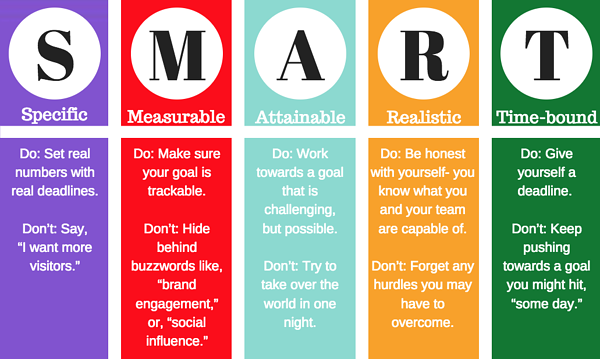What is goal setting?
Goal-setting is the process of taking active steps to achieve your desired outcome. Maybe your dream is to become a teacher, musician or physical therapist. Each one of these dreams involves setting and reaching small (and big!) goals. Each of these major goals can be broken down into smaller, more attainable goals that will propel you towards success.
There are three types of goals- process, performance, and outcome goals.
- Process goals are specific actions or ‘processes’ of performing. For example, aiming to study for 2 hours after dinner every day . Process goals are 100% controllable by the individual.
- Performance goals are based on personal standard. For example, aiming to achieve a 3.5 GPA. Personal goals are mostly controllable.
- Outcome goals are based on winning. For a college student, this could look like landing a job in your field or landing job at a particular place of employment you wanted. Outcome goals are very difficult to control because of other outside influences.
Process, performance, and outcome goals have a linear relationship. This is important because if you achieve your process goals, you give yourself a good chance to achieve your performance goals. Similarly, when you achieve your performance goals, you have a better chance of achieving your outcome goal.
1. The Vision
Before there’s a goal, there has to be a larger vision, or what I like to call a “formation.” Think about how the Bible says in Jeremiah 1:5 that God formed us in our mother’s womb. Who has He formed you to be? What kind of person do you want to become as you learn and grow in your life? That’s the big picture you should always keep in mind, even before you set your goals. The why behind your goals will really drive you and keep you motivated.
2. The Goals
Goals are what you set in order to help you work toward the vision. All goals should be SMART: specific, measurable, achievable, relevant and time-sensitive. It doesn’t matter if your time limit for your goal is a month, a year, or a decade, as long as it’s in line with your God-given vision.
3. The Habits
Maintaining that goal once you’ve already hit it is a real challenge—that’s why habits are important. You have to create some smaller, consistent habits that help you achieve your goals. That way, once you reach your goal, you’ve already established a pattern that will help you stick with it over time. That’s how lives change, you guys.
Think of it this way: Habits are kind of like the compound interest of self-improvement. Invest your time and energy now, and you’ll get a big payoff later.
General Goal Setting Tips
- set both short- and long-term goals
- set SMART goals
- set goals that motivate you
- write your goals down and put them in a place you can see
- adjust your goals as necessary
- Recognize and reward yourself when you meet a goal
Set SMART Goals
Set all three types of goals- process, performance, and outcome – but focus on executing your smaller process goals to give you the best chance for success!
- specific – highly detailed statement on what you want to accomplish (use who, what, where, how etc.)
- Measurable- how will you demonstrate and evaluate how your goal has been met?
- Attainable- they can be achieved by your own hard work and dedication- make sure your goals are within your ability to achieve
- Relevant- how does your goals align with your objectives?
- Time based- set 1 or more target dates- these are the “by whens” to guide your goal to successful and timely completion (include deadlines, frequency and dates)
GOALS
Long term dreams – Short term goals
- Creating a 20 year vision for your life and deciding first steps towards it
- Set goals in 7 different areas of life over multiple time-frames (social, family, health, career, finances, learning, character)
- Set goals related to each of the roles you find yourself playing in life (friend, colleague, brother, father, son etc…)
- Set some things you’d like to achieve this year
- Choosing your top 3 things to focus on right now
- Your main goal right now – to go through your main goal in great detail
Set goals for different areas in your life
- Your social life – goals to enhance the connections in your life (goals may include to surprise a friend with a thoughtful gift, or to show you’re thinking of a loved one, to find love, to go on holiday with someone to strengthen your connection, doing something fun or something new with someone, doing more of what you love to do with someone who also loves it)
- Your family (do you want to expand your family, have children, help someone in your family achieve something, help your family become closer, support a family member in some way)
- Your health (do you want to exercise more, lose weight, take up a sport, eat healthier, improve your nutritional awareness or balance, improve your psychological health, increase your strength)
- Your career (would you like to start a new career, get a promotion, create a new income stream, look for new directions, start a business, expand your current business)
- Your finances (Is it time to save money, pay off debts, expand your capital, spend less, invest, create new sources of income)
- Your learning (are you keen to learn something new, deeper your knowledge of a particular topic, go back to university and master some topic, read quality books intended to improve your life in some way, take a course to improve some area of your life, do some self-initiated work based learning)
- Your character (how about a focus on strengthening your character. is it time to work with a counsellor, or a life or transformational coach, would you like to enhance the gratitude in your life, or your grit in tough situations, or increase your awareness of your character strengths and use them more often, the possibilities are endless).
Set goals for each role in your life
As A
Person
Parent
Husband
Son
Daughter
Business Owner
Student
Employee
Friend
This years goals
- what 5 things are most important for you to focus on this year
- when you imagine you’ll see some positive result in each goal
- what action steps you could potentially take that will cause progress towards your top 5 goals
Top 3 things I’m focusing on right now
- what 3 things are most important for you to focus on you right now
- when you’d like to see some positive result by in each area
- what action steps you’d like to take first towards your 3 goals
- you can also bring into the limelight the qualities or strengths relevant to each goal that you have. i.e. is your kindness going to support you in reaching this goal? or perhaps your social intelligence? Or you’re leadership ability?
Your main goal right now
Start Date – Target Date
Why this goal is important to me
How Will I achieve this goal?
Strengths to help me achieve this goal
Obsicals that may arise
How I plan to respond to obsicals
What Will Be Different When I Achieve This Goal
Next Best Steps
Downloadable Work Sheets

Types of business goals
Goals can be separated into four types of organizational categories.
1. Time-based goals
Long-term goals
A long-term goal represents the big picture or overall direction of your team, company, or project. These goals stretch out over an extended time period, potentially months or even years down the road.
Example:
- Make Acme Co the market leader in business software.
Short-term goals
Short-term objectives are how you break out a long-term goal into more sizable bits. They’re clearly defined and easy to measure or evaluate over a set period of time, such as a month or a quarter.
Building on the example above, some short term goals to support that long-term goal of market leadership could include:
- Improve customer satisfaction.
- Build new business software products.
- Increase awareness amongst consumers.
2. Performance-based goals
Performance-based goals are short-term objectives set for specific duties or tasks. They are also clearly defined and easy to measure or evaluate. These can also be used to measure employee performance.
Examples:
- Improve customer satisfaction for existing products by 10% in Q1.
- Invest 25% more engineer time in building new business software.
- Increase share of voice in the area of business software by 25% via Marketing campaigns.
3. Quantitative vs. qualitative goals
Quantitative goals are evaluated based on numbers or statistics, like if your team’s freshly launched webpage is receiving the projected number of hits per page. (SMART goals are a great tool for setting specific, measurable, and achievable targets.) Qualitative goals are not as cut-and-dry, such as how the website is being received by your users.
Example of a quantitative goal:
- Our newly re-designed business software website has increased user interaction on the page by 30%.
Example of a qualitative goal:
- Customers think the redesign presents information about our company in a better and more engaging manner.
4. Outcome- vs. process-oriented goals
Outcome is the result you’re aiming for, while process refers to the processes that will lead to the desired outcome if you follow them repeatedly.
Process goals are more immediate and tangible, and they keep you moving forward toward your outcome goals.
Example of an outcome-oriented goal:
- Launch a new website by the end of the first quarter.
Example of a process-oriented goal:
- Follow a 2-week sprint to ensure design and development is being completed on time.
- Hold weekly standups with the website redesign team to catch up on tasks in progress.
Types of Goal Setting
There are seven types of goals. Many goals can be set from a single section, or a single goal from each one. It all depends on the priorities of the individual.
To be “well rounded” you will want to mix it up a bit, and not JUST focus on a single target. But ultimately any decision on where to put your effort is yours and yours alone. Don’t let anybody tell you any different.
These are not cookie-cutter decisions that require one from each category. They are choices based on your life.
The idea of their being seven Goals (and their names) comes from Jack Canfield and his book, The Success Principles. (You can read the review of this book here.)
#1. Career Goals
This is the most commonly what people think about then they think, “Goal setting activities”. And are often the things that pop into people’s head when they think about the different types of goals they could be setting.
With career goals should focus on how to:
- Get a promotion
- Improve job performance
- Learn a new skill related to your career
- Look for a career change
- Improve communication
- Develop your soft skills (Here is a list of 135 soft skills)
- Get a specific award/accolade
- Start your own business
- Create a side hustle for extra money
- Become the “go to” expert on _____
- Increase creativity
- Make more money for company and yourself
#2. Financial Goals
- Make—and stick to—a zero-based budgetevery month. Try using a budgeting app like EveryDollar to help you track all of your spending.
- Save up a starter emergency fund of $1,000 by a certain date by setting aside money from every paycheck for savings.
- Pay off all debt by a certain date by cutting something (like entertainment or clothes shopping) out of your budget for a few months, selling a specific amount of items you don’t need, getting rid of all credit cards, staying away from money traps . . . the list goes on.
- Start investing so you can retire when you want to by setting up your 401(k) if your job offers one with a match, and putting a certain amount of money into a Roth IRA every month.
- Cash flow college and graduate with zero debt by finding affordable colleges, working through school, filling out the FAFSA, and following the plan in Debt-Free Degree. Peace out, student loans!
#3. Personal Development Goals
Personal development goals are the ones that are about making you a better person. This is not a judgment. For example, I am not saying that if you only speak a single language there is something wrong with you. But if you feel you need to learn another language then it becomes an important goal that will make you a bit better.
Personal development goal examples:
Goals Learn a foreign language
Write a book
Learn to speed read
Learn new skills
Read more books
Find a mentor (and establish SMART goals for mentoring)
Create a blog/online course
Improve body language/ confidence
Start a morning routine
Have a better attitude
Travel to specific destinations
#4. Spiritual Goals
What can you do for your spirit? What can bring you authentic happiness? These can be religious goals for any religion. They can be goals that help you contribute to society. These include any goals that are about more than yourself and your immediate family.
Examples of spiritual goals:
- Have a better prayer life by praying, reading and journaling for a set amount of time every morning.
- Be part of a close community of believers by joining a small group and committing to going every week.
- Serve the people around you by signing up to volunteer on a regular basis at your church or in your community.
- Have an in-depth understanding of a specific part of the Bible by leading or going to a scheduled Bible study.
- Know Scripture by heart by memorizing one of your favorite verses every month (so you can whip it out when you or someone else needs some encouragement).
- Cut gossip out of your life by saying something positive every time you catch yourself wanting to gossip—or hear someone else gossiping. Ain’t nobody got time for that.
#5. Educational Goals
Educational goals are a bit of a hybrid. In college, this will be of paramount importance as you struggle to learn and set yourself up for a career. Later on in life, this does not become as important, but you are fooling yourself if you think that as a 50-year-old manager, you still do not need to educate yourself.
Education goals have some crossover. They often crossover with personal development and Career. But mostly your educational goals after college will deal with specific things you need for your education/career/job/future job.
Since this “educational” training varies greatly from career path to career path I will not list all the items on the list.
#6. Relationship Goals
A few relationship goals are:
- Leave stress at work
- Dedicate alone time with your child/spouse
- Get more free time
- Increase family time
- Find a significant other
- Have children
- Get married
- Save for children’s goals
#7. Physical and Health Goals
Common physical and health goals are:
- Start each day with this nutritious green drink
- Keep vital signs in normal ranges
- Stay fit and active
- Have a regular exercise routine
- Achieve a massive physical fitness goal.
- Keep your immune system operating at peak condition
- Have the energy to get more done
- Live forever. Or at least live to your 90s and beyond being healthy the whole way.
#8 Family Goals
Yep, that’s right—family is so important, it’s an entire goal category. I realize it might sound weird to set goals that have to do with your family, but when you put some intentional effort into those relationships, you might be surprised at how strong your bond becomes. Don’t get so busy that you don’t have time for your family (and the ride-or-die people in your life who you think of as your family).
This year, I want to travel home more often to spend as much time as possible with my people. So I’m planning a specific number of trips over the course of the year. Here are some more examples of family goals you could set:
- Keep your relationship with your parents going strong by calling them once a week to catch up.
- Plan a trip to surprise your grandparents by setting aside the money every paycheck in a sinking fund (that’s just a category in your budget that you use for a set purpose).
- Stay involved in your siblings’ lives by setting a coffee date with them once a month. Or if they live far away, that sinking fund thing works for this, too.
- Brighten your fam’s lives by reminding them on a regular basis how much you love and appreciate them. (Speaking of fam, have I told y’all how much I appreciate you? It’s the truth.)
Most of us never really reach our potential and we don’t live the life we could live. Most people can double or triple their income just by consistently applying what they already know. They already know what they need to do to achieve their goals but they do not consistently execute these actions. In order to reach your potential, all you need to do is consistently execute your plans. Effective execution is the best way to accomplish all your goals. The idea is not to work harder, but to focus on the activities that matter most and get them done. The 12 Week Year has the power to increase your income two, three, or four times. It also has the power to help you reach similar goals in all areas of your life!
1 The 12 Week Year: Get More Done in 12 Weeks than Others Do in 12 Months
2 Your Vision and Long-Term Goals
2.1 Long-term aspirations
2.2 Mid-term goals
2.3 12-Week Goals
2.4 Tactics 3 Implementation Plan
3.1 Step 1 – Set your goals
3.2 Step 2 – Develop a plan to achieve your goals
3.3 Step 3 – Create a Weekly Plan
3.4 Step 4 – Complete each action the week it is due
3.5 Step 5 – Measure your progress with the Weekly Scorecard
4 Planning and Reflection
5 12 Week Year Planner
YOUR VISION AND LONG-TERM GOALS
Before you start, you will need to create a vision to know where you want to get to. Without a vision, you will have no emotional connection to your tasks, and your chances of success will not be as great. There are 3-time horizons you’ll want to focus your vision on:
Just answer these questions
LONG-TERM ASPIRATIONS
How would you like to see your life in the long term?
MID-TERM GOALS
What would you like to achieve 3 years from today? Relate to personal and professional goals.
12 WEEK GOALS
These are your goals for the next 12 weeks. This is your vision and where you want to be 12 weeks from now.

Use this goal worksheet to write each of the three goals.
Image | Word | Editable PDF
It is important to write clear and precise goals. This will increase your chances of getting to where you want to be. When you set goals for the next 3 months, they will be more predictable than goals you set for the next year. Also, when you set goals four times a year, you will focus on fewer goals. That means you are more focused and less distracted. In 12 week planning, you identify the top one to three things that will have the greatest impact, and then work to accomplish each of these things.
TACTICS
These are the actions you will take to reach your 12-week goals.
IMPLEMENTATION PLAN
Your goals must be:
S – Specific or Significant
M – Measurable or Meaningful
A – Attainable, Achievable or Action-oriented
R – Relevant or Rewarding
T – Timely or Trackable
SMART goals have a higher chance of success since they are specific, measurable, achievable, realistic, and timely. Every goal can be made S.M.A.R.T. and as such, has a better chance of becoming reality.
- Specific and measurable.
- Stated positively. Focus on something positive that you want to happen.
- Realistic but require effort to achieve. You don’t want your goals to be too easy to achieve, but you also don’t want them to be too difficult to achieve. Try to find goals that challenge you but are achievable with reasonable effort.
- Find ways to hold yourself accountable. Accountability keeps you working hard to make consistent, steady progress, and to achieve your goals. The ultimate aim of accountability is to continually ask yourself what you can do to reach your goals.
- Time-bound. You need a deadline to get yourself moving.


Typeable PDF | Word | Excel Typeable PDF | Word | Excel
SPECIFIC
Goals that are well defined, detailed, and clear, have a much greater chance of being reached. To make a goal specific, try to relate to the five “W” questions:
- What do I need to do?
- Where will I reach this goal?
- When will I reach the goal by?
- Who needs to be involved to achieve this goal?
- Why do I want to achieve this goal? This is important to keep you motivated and on track and to ensure that the goal is meaningful and worth your time and energy.
Use the SMART goal sheet to answer each of these questions.
MEASURABLE
A goal must be measurable so that you can measure your progress and determine if you are on track. You should be able to tell when you reach your goal.
Example: My goal is to lose 14 lbs and to work out five days a week.
ACHIEVABLE
The goal should require work and not be too easy but should be attainable with some effort on your part. Take your available time, skills, and financial situation into account, and whether you can achieve the goal with reasonable effort. Don’t set goals that are too difficult or overwhelming. If your goals are too big, then break them up into mini-goals or baby steps.
Example: I know I can lose 14 lbs since I have done it before. I have also worked out 5 times a week before so I know it is achievable.
If that sounds overwhelming then set a goal to lose 2lbs only. When you reach that goal you will set another goal.
REALISTIC
A goal must be realistically achievable within the given time frame and with your available resources.
Example: Since it works out to be about 1 lb a week which is a realistic weight loss my goal is realistic.
TIMELY
A goal must have a start and finish date. You must also have the time to do each of the steps you will need to take.
Example: I will start now and reach my goal in 3 months. I will exercise five times each week and lose about 1 pound each week for 3 months.
It is important that your goal is positive. You want to focus on what you want to do and not what you don’t want to do. What you focus on, increases. So when you focus on not doing something, then that will increase too.
Goals List

Image | Word | Editable PDF | Excel Spreadsheet
Daily Goals Template
You can use this goal list template for daily goals or for any other period. The daily goal sheet does not have set categories as do the longer periods.

Image | Word | Editable PDF | Excel Spreadsheet
Weekly Goals Template
This weekly goals template will help you reflect on the previous week and set weekly goals. The weekly goals sheet below helps you set weekly goals.

Monthly Goals Template
This monthly goal sheet includes a section to reflect on last month and improve on things you can do better. The next section helps you set your monthly goals and track them. You can also print a goal calendar or print one of our blank calendars and fill in your goals and your action steps on the days you plan to do them.

Image | Word | Editable PDF | Excel Spreadsheet
Yearly Goals Template
It is important to set long-term goals as well as short-term daily goals. A long-term goal will keep you on track and remind you where you are striving to reach in the long run. This will keep you motivated and prevent you from getting sidetracked.

Image | Word | Editable PDF | Excel Spreadsheet
12 Week Year Goals
The 12-week year plan includes one to three goals with all the tactics or actions you need to execute in order to achieve your 12-week goals. The idea is to list the top priorities that will add the most value and have the greatest impact. You then make sure you complete these actions.

Image | Word | Editable PDF
there are 3 time horizons you’ll want to focus your vision and goals on. Use this goal worksheet to set each of the three goals.

Image | Word | Editable PDF
STEP 1: WHAT ARE YOUR ISSUES WITH YOUR LIFE AT THE MOMENT?

STEP 2: WHAT IS A PERFECT LIFE IN YOUR OPINION

STEP 3: SET A REALISTIC GOAL FOR EACH AREA


personal goals
- Family: Do you want to be a better parent?
Do you spend enough time with your family or your partner? How do you get along with your siblings? Do you work on the relationship? - Health: Do you lead a healthy lifestyle? What steps can you take to improve your health and fitness?
- Financial– How much do you want to earn? How and when do you want to reach this goal? How much do you want to save?
- Social – Do you socialize enough? Do you enjoy yourself?
- Education – Do you want to further your education? Is there any knowledge or skills you want to acquire? What skills will you need to have in order to reach your goals?
- Career– What level do you want to reach in your career? What are your goals?
- Character – Do you have any traits you would like to work on? Does your mindset hold you back? Is there anything about your behavior that you think you should improve?
- Home – Do you want to organize your home or make any improvements to it?
- Fitness – Do you have any fitness or athletic goals?
- Artistic– Do you want to achieve any artistic goals?
- Pleasure– How do you want to enjoy yourself? Some people don’t take enough time off to enjoy their selves and might need to set goals and slot this time in their planner.
- Public Service– What you would like to do to make the world a better place?
- Relationship Goals: How many new people did you meet this week? For example, focus on introducing yourself to two new people each month for the next 6 months.
STEP 4: SMART GOAL SETTING WORKSHEET
Prioritize your goals and make each Goal SMART
Write down each goal from the “My Goals” worksheet in the previous step in the “Initial Goal” section on the “Smart Goals” worksheet. Put each goal on a separate page. There are seven copies of the SMART goals page in the goal journal. In the first block, write down the initial goal. Turn each goal into a SMART goal. To do this, ask yourself each of the five SMART questions and write down the answer to them in the relevant section. Rewrite your initial goal taking into account each of the lines above.
SMART goal setting will ensure your goals have the best chance of success.
STEP 5: WHAT ARE THE REASONS YOU WANT TO ACHIEVE YOUR GOALS?
Any goal that is worth achieving is going to take you out of your comfort zone. If it doesn’t, then it probably won’t be as significant. This page will keep you motivated. When you are feeling challenged, frustrated, or despondent, read this page to remember why you want to achieve your goals.
There are also six motivational goal quotesthroughout the printable planner to keep you motivated.

STEP 6: BRAINSTORMING
Take the revised SMART goal and rewrite it at the top of the page. Make a list of things that you could do in order to reach the goal. Try to come up with 6 ways to accomplish each goal. For each option, write a few tasks that would help you achieve this.

***The PDF version is editable and you can type on it. However, if you prefer working with Excel, then select the goal-setting template Excel format. The Word version is helpful if you want to edit the template.***







